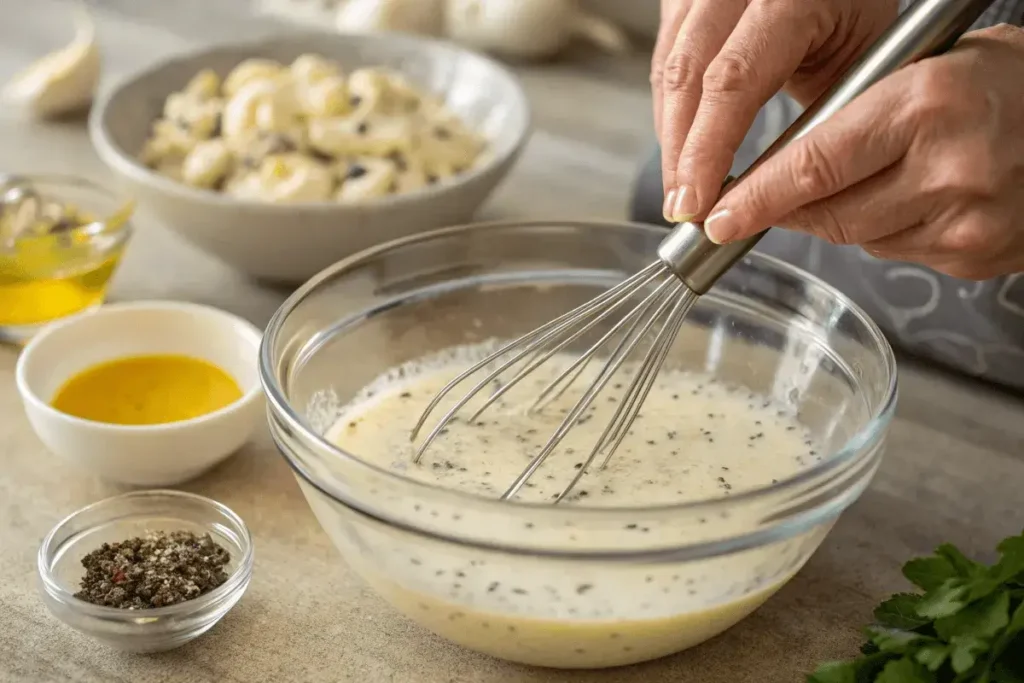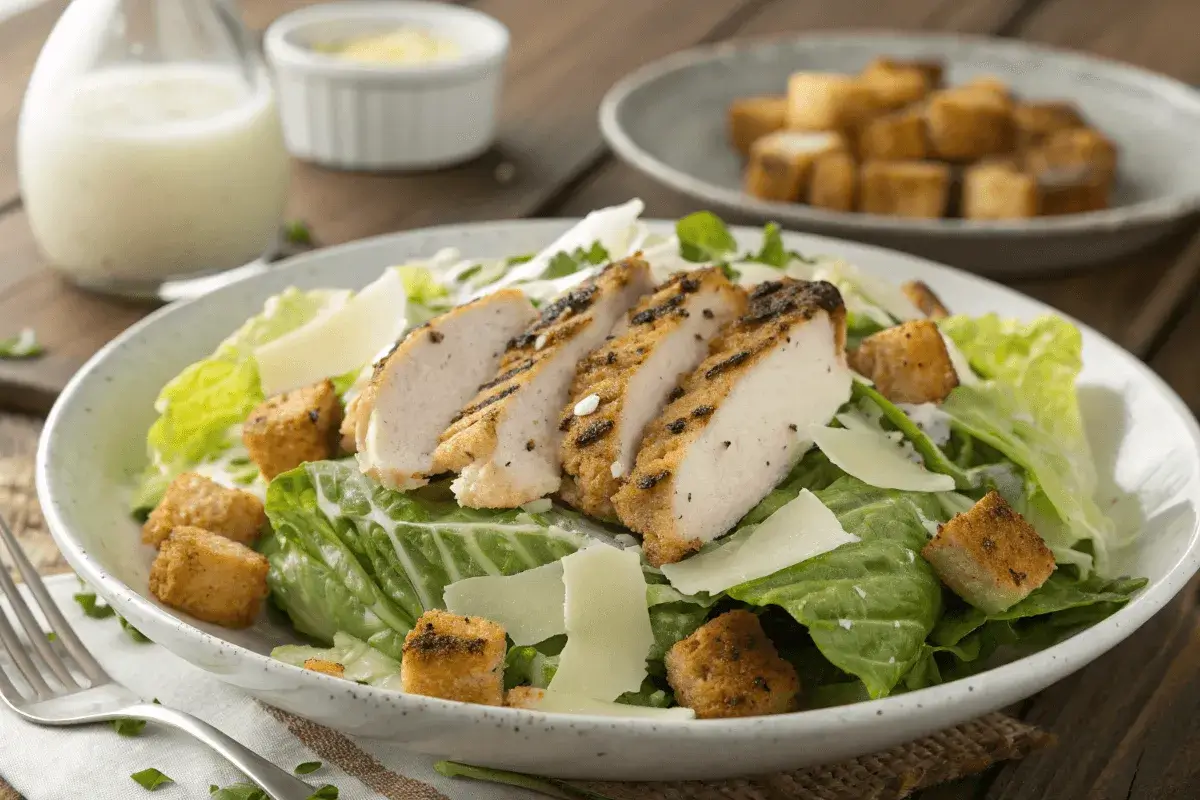Table of Contents
Introduction
Chicken Caesar salad is a timeless dish that blends crisp romaine lettuce, juicy grilled chicken, crunchy croutons, and rich Parmesan cheese, all tossed in a creamy, tangy Caesar dressing. Whether served as a light meal or a hearty entrée, this salad remains a favorite worldwide.
In this guide, we’ll explore everything you need to know about making the best chicken Caesar salad, from its origins and essential ingredients to step-by-step instructions for the perfect homemade version. You’ll also find tips for making a healthier version, avoiding common mistakes, and customizing the recipe to suit your taste.
Let’s dive in!
Part 1: What Is Chicken Caesar Salad?
Origins and History of Chicken Caesar Salad
Despite popular belief, Caesar salad wasn’t named after Julius Caesar. It was created in 1924 by Caesar Cardini, an Italian-American restaurateur in Tijuana, Mexico. The original version contained romaine lettuce, garlic, croutons, Parmesan cheese, egg, Worcestershire sauce, and olive oil.
The chicken Caesar salad variation came later, as grilled chicken was added to make it a more filling and protein-rich dish. Today, it’s a go-to meal for those looking for a delicious and satisfying salad.
Why Is Chicken Caesar Salad So Popular?
There’s a reason why chicken Caesar salad remains a favorite among salad lovers:
- Balanced Flavors – The mix of crisp lettuce, savory chicken, creamy dressing, and crunchy croutons creates a perfect bite every time.
- Versatile Meal Option – It can be a light lunch, a protein-packed dinner, or even a side dish at barbecues and parties.
- Easy to Make – With simple ingredients and minimal cooking, you can prepare a restaurant-quality salad at home.
Now that we’ve covered the history and appeal of chicken Caesar salad, let’s explore the essential ingredients that make it so delicious.
Part 2: Essential Ingredients for the Best Chicken Caesar Salad
A great chicken Caesar salad starts with fresh, high-quality ingredients. Each element contributes to the dish’s signature taste and texture.
What Goes in a Chicken Caesar Salad?
The classic chicken Caesar salad is built with a few key components:
- Romaine Lettuce – Crisp and refreshing, it provides the perfect crunch.
- Grilled Chicken – Tender, seasoned chicken adds protein and flavor.
- Parmesan Cheese – Aged Parmesan gives a nutty, salty taste.
- Croutons – Toasted bread pieces offer a crispy texture.
- Caesar Dressing – A creamy, garlicky dressing that ties everything together.
Choosing the Best Ingredients
To elevate your chicken Caesar salad, pay attention to the quality of each ingredient:
- Lettuce: Romaine is the traditional choice, but kale or mixed greens can be used for variety.
- Chicken: Grilled, baked, or pan-seared chicken breast works best.
- Parmesan Cheese: Freshly shaved Parmesan has a richer taste than pre-grated versions.
- Croutons: Homemade croutons from toasted bread add a more authentic touch.
- Dressing: A homemade Caesar dressing beats store-bought options for freshness and flavor.
Now that we’ve covered the ingredients, let’s move on to making the perfect chicken Caesar salad step by step.

Part 3: How to Make the Perfect Chicken Caesar Salad
Creating a fresh and flavorful Caesar salad at home is easier than you might think. With a few simple techniques, you can achieve the perfect balance of crisp greens, tender chicken, crunchy croutons, and creamy dressing.
Step-by-Step Recipe for a Delicious Salad
- Cook the Chicken – Season with salt, pepper, garlic powder, and olive oil, then grill or bake until golden brown.
- Prepare the Croutons – Cube fresh bread, toss with olive oil and seasonings, then bake at 375°F until crisp.
- Assemble the Ingredients – Chop romaine lettuce, add sliced or shredded chicken, sprinkle with Parmesan, and toss in the croutons.
- Add the Dressing – Drizzle the desired amount of dressing and mix gently to coat everything evenly.
Best Cooking Techniques for Tender, Juicy Chicken
For the best texture and flavor, follow these simple tips:
- Marinate for Extra Flavor – Let the chicken soak in olive oil, lemon juice, and seasonings for at least 30 minutes before cooking.
- Avoid Drying It Out – Use a meat thermometer to check that it reaches an internal temperature of 165°F.
- Let It Rest Before Slicing – Allowing it to sit for 5 minutes helps lock in the juices.
Homemade vs. Store-Bought Caesar Dressing
While pre-made dressings are convenient, making your own adds a fresh, rich flavor that elevates the dish.
- Homemade: Made with garlic, anchovies, egg yolk, Dijon mustard, olive oil, and Parmesan, creating a creamy and tangy taste.
- Store-Bought: A quick alternative, but often contains preservatives and added sugars, which can alter the flavor.
Now that you’ve prepared a restaurant-quality salad, let’s take a closer look at what makes Caesar dressing so special in the next section.
If you’re looking for more delicious recipes, you might enjoy their Chipotle Queso Recipe for a flavorful dip that pairs well with various meals.
Part 4: How to Make Classic Caesar Salad Dressing
The key to an outstanding Caesar salad is its rich, creamy, and tangy dressing. While store-bought options are convenient, a homemade version offers fresher flavors and better texture.
What Are the Main Ingredients in Caesar Dressing?
A traditional dressing is made using:
- Egg yolk – Helps emulsify the ingredients, creating a smooth consistency.
- Anchovies – Contributes a deep, savory umami flavor.
- Garlic – Adds a bold and aromatic punch.
- Dijon mustard – Enhances tanginess and aids in emulsification.
- Lemon juice – Brings a bright, fresh acidity.
- Olive oil – Forms the base, giving the dressing its silky texture.
- Parmesan cheese – Provides a salty, nutty depth.
- Worcestershire sauce – Balances flavors with a touch of sweetness and tang.
For a lighter alternative, consider swapping in Greek yogurt for the egg yolk or using a mild vinaigrette instead. If you prefer a milder taste, anchovies can be omitted.
Step-by-Step Guide to Making Caesar Dressing
Follow these simple steps for a flavorful homemade dressing:
- Mash the Anchovies and Garlic – Use a fork or mortar and pestle to form a paste.
- Whisk the Wet Ingredients – In a bowl, combine egg yolk, Dijon mustard, Worcestershire sauce, and lemon juice.
- Slowly Add Olive Oil – Drizzle in the oil gradually while whisking to achieve emulsification.
- Incorporate Parmesan – Stir in freshly grated cheese for extra richness.
- Taste and Adjust – Add salt and pepper as needed. If the consistency is too thick, thin it out with a little water.
This homemade dressing can be stored in the refrigerator for up to a week. Stir or shake before using for the best consistency.
With the dressing prepared, let’s explore different ways to customize this salad to match your preferences.

Part 5: Variations of Chicken Caesar Salad
While the classic chicken Caesar salad is a favorite, there are plenty of ways to switch it up to fit different dietary preferences and taste preferences.
Creative Twists on the Classic Recipe
- Avocado Chicken Caesar Salad – Add sliced avocado for a creamy, buttery texture.
- Bacon Caesar Salad – Crispy bacon crumbles enhance the smoky, savory flavors.
- Spicy Caesar Salad – Toss in chili flakes or chipotle powder for a spicy kick.
- Blackened Chicken Caesar Salad – Use spicy blackened seasoning on the chicken for bold flavor.
- Caesar Pasta Salad – Mix in cooked penne or rotini pasta for a heartier dish.
Low-Carb and Healthier Options
If you’re looking for a healthier version of chicken Caesar salad, consider these simple modifications:
- Skip the Croutons – Replace them with toasted almonds or sunflower seeds for crunch.
- Use Greek Yogurt Dressing – Swap traditional Caesar dressing for a Greek yogurt-based version to cut down on calories.
- Grill the Chicken with Herbs – Season chicken with herbs and lemon juice instead of heavy marinades.
- Go Dairy-Free – Replace Parmesan with nutritional yeast or dairy-free cheese.
With so many variations, you can enjoy chicken Caesar salad in different ways while keeping it fresh and exciting.
Part 6: Is Chicken Caesar Salad Healthy?
Many people wonder whether chicken Caesar salad is a healthy meal choice. The answer depends on the ingredients used and portion sizes. While this salad is packed with protein and essential nutrients, certain elements—like creamy dressing and croutons—can add extra calories.
Nutritional Breakdown of Chicken Caesar Salad
A standard serving of chicken Caesar salad contains:
- Calories – Around 400–600 calories, depending on the dressing and toppings.
- Protein – 30–40g of protein from grilled chicken and Parmesan cheese.
- Fats – 25–40g of fat, primarily from the dressing and cheese.
- Carbohydrates – 20–30g, mainly from croutons and dressing ingredients.
While the salad provides protein and healthy fats, the high-calorie dressing and croutons can make it less diet-friendly. However, with a few modifications, you can enjoy a healthier version without sacrificing flavor.
How to Make a Healthier Chicken Caesar Salad
If you want to lighten up your chicken Caesar salad, try these simple adjustments:
- Use a Lighter Dressing – Swap traditional Caesar dressing for a Greek yogurt-based alternative or a vinaigrette.
- Reduce the Croutons – Cut back on croutons or replace them with toasted almonds or seeds for a lower-carb option.
- Grill Instead of Frying – Use grilled or baked chicken instead of fried or breaded varieties.
- Add More Greens – Mix in kale, spinach, or arugula to boost fiber and vitamins.
By making these small changes, you can enjoy a nutritious and satisfying chicken Caesar salad that fits into a balanced diet.
Part 7: Common Mistakes to Avoid When Making Chicken Caesar Salad
Even though chicken Caesar salad is simple to prepare, there are a few common mistakes that can affect its taste and texture. Avoid these pitfalls to ensure your salad is as delicious and authentic as possible.
Mistakes That Ruin a Caesar Salad
- Using the Wrong Lettuce – Romaine is the best choice for chicken Caesar salad. Substituting with iceberg or mixed greens can change the texture and flavor.
- Overdressing the Salad – Too much dressing can make the salad soggy, while too little can leave it dry. Add dressing gradually and toss evenly.
- Skipping Fresh Ingredients – Pre-grated Parmesan and store-bought croutons may lack the depth of flavor that fresh, homemade versions provide.
How to Keep Croutons Crispy and Chicken Juicy
- Crispy Croutons: Bake croutons at 375°F until golden brown, and let them cool before adding to the salad.
- Juicy Chicken: Let grilled or baked chicken rest for 5 minutes before slicing to keep it moist.
By avoiding these common mistakes, you’ll ensure that your chicken Caesar salad is always fresh, crisp, and flavorful.

Part 8: FAQs About Chicken Caesar Salad
Many people have questions about this popular dish, from its ingredients to its nutritional value. Below are answers to some of the most common inquiries.
What Are the Main Ingredients in This Salad?
A traditional version includes romaine lettuce, grilled chicken, Parmesan cheese, croutons, and creamy dressing. Some variations feature avocado, bacon, or cherry tomatoes for added flavor.
Is This Salad a Healthy Choice?
It depends on the portion size and ingredients used. While it provides lean protein and essential nutrients, the dressing and croutons can contribute extra calories. To make a lighter version, try whole grain croutons, a yogurt-based dressing, or extra greens.
How Is the Dressing Made?
The classic dressing is a blend of egg yolk, anchovies, garlic, Dijon mustard, lemon juice, olive oil, and Parmesan cheese. For a healthier alternative, swap in Greek yogurt or a tangy vinaigrette.
What Makes a Caesar Salad Different?
A basic version consists of romaine lettuce, Parmesan cheese, croutons, and Caesar dressing. Adding grilled chicken turns it into a protein-packed meal, making it more satisfying.
With these common questions covered, let’s wrap up everything we’ve learned.
Part 9: Conclusion
Chicken Caesar salad is a timeless and versatile dish that combines crisp romaine lettuce, juicy grilled chicken, crunchy croutons, and creamy dressing. Whether enjoyed as a light lunch, hearty dinner, or side dish, it’s a go-to favorite for salad lovers everywhere.
We’ve explored the history, essential ingredients, step-by-step recipe, and variations of this classic salad. We also covered tips for making it healthier, common mistakes to avoid, and answers to frequently asked questions.
Now that you have all the information you need, it’s time to make your own chicken Caesar salad at home! With fresh ingredients and the right techniques, you’ll enjoy a restaurant-quality salad every time.

